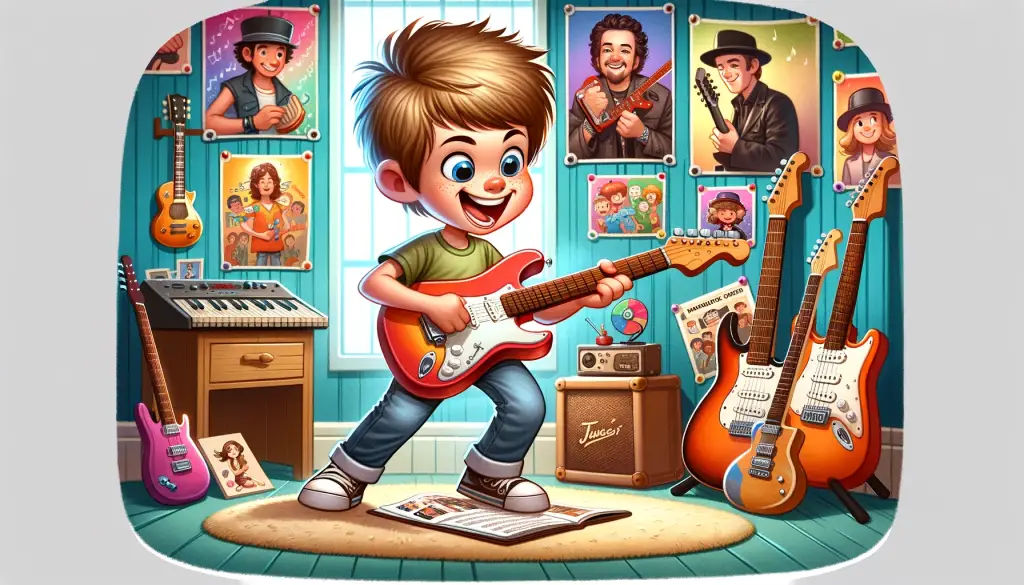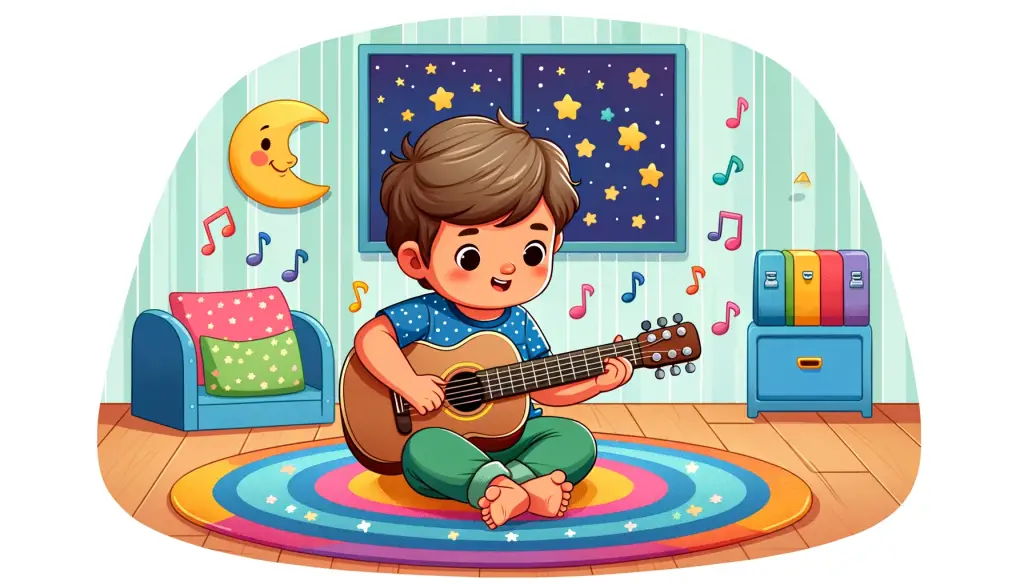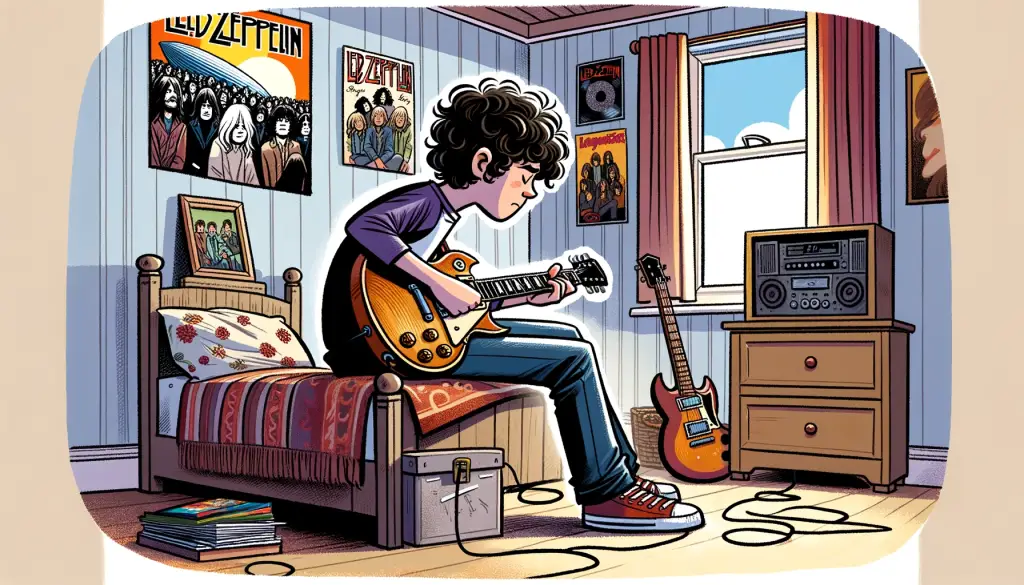Playing guitar is a fantastic way for young children to explore music. Easy guitar songs can open a world of creativity and enjoyment. This guide is perfect for parents and guitar teachers looking to introduce little kids to the simple joys of playing guitar. We’ll explore a range of easy songs, from classic nursery rhymes to popular kids’ songs, that are great for beginners.
Why Guitar Is a Great Instrument for Kids
Guitar playing offers numerous benefits for young children, making it a perfect choice for early musical exploration. Whether it’s strumming simple chords or learning a full song, the guitar provides a fun and engaging way for kids to develop various skills.
The Benefits of Learning Guitar at a Young Age
Development of Fine Motor Skills and Coordination: Playing guitar helps young children improve their fine motor skills. Handling the guitar, managing chord shapes, and strumming all contribute to better hand-eye coordination.
Enhances Cognitive Abilities: Learning to play easy guitar songs can boost cognitive development in children. It involves memory, concentration, and problem-solving skills, especially when following charts or reading sheet music.
Boosts Self-Esteem and Confidence: Mastering a new skill, like playing a great song on the guitar, provides a sense of achievement. This sense of accomplishment is crucial in building self-esteem in young children.
Cultural and Emotional Awareness: Through learning different songs, including popular kids songs and classic nursery rhymes, children gain exposure to various cultures and emotional expressions.
Encourages Discipline and Patience: Learning an instrument like the guitar requires regular practice. This instills a sense of discipline and patience, as children understand that progress comes with consistent effort.
Acoustic vs. Electric Guitars for Children
When choosing between an acoustic guitar and an electric guitar for children, several factors come into play.
Acoustic Guitars: These are often recommended for beginners, especially for little kids. Acoustic guitars are great for learning basic guitar chords, simple strum patterns, and are generally more portable and affordable. The nylon strings of classical acoustic guitars are easier on young fingers, making them ideal for practicing basic strum patterns and simple songs like “Twinkle Twinkle Little Star” or “Baa Baa Black Sheep”.
Electric Guitars: Electric guitars might appeal to children interested in pop songs or rock music. They require less finger strength to play, which can be advantageous for young children. However, electric guitars need additional equipment like amplifiers, which can be an added expense. They offer a wide range of sounds and techniques, which can be exciting for kids who have a bit of experience and are looking to explore more complex songs or chord changes.
In conclusion, both types of guitars have their advantages. The choice often depends on the child’s musical interests, physical comfort with the instrument, and the type of music they are excited to learn, whether it be classic nursery rhymes or contemporary pop songs.
Starting with an acoustic guitar can be a great way for kids to get a flying start with simple structure songs, learning basic open chords and enjoying the straightforward strum patterns of children’s songs. As they progress, the electric guitar can introduce them to a whole new world of sounds, perfect for those who want to explore more diverse genres like Disney songs or show tunes.
Ultimately, whether it’s an acoustic or electric guitar, the joy and educational benefits of playing guitar make it an excellent choice for young children. It’s not just about learning an instrument; it’s about sparking a lifelong love for music, creativity, and self-expression.

Starting with the Basics
Learning to play guitar starts with understanding the fundamentals. For young guitar players, beginning with basic guitar chords and simple rhythms lays the foundation for a lifetime of musical enjoyment.
Understanding Basic Guitar Chords and Chord Shapes
Introduction to Basic Chords: The journey into guitar playing often starts with learning basic open chords. These chords are the building blocks for playing a variety of easy guitar songs. For example, songs like “Hot Cross Buns” or “Baa Baa Black Sheep” can be played using simple chords.
Familiarizing with Chord Shapes: Recognizing and memorizing chord shapes is essential for young children. Chord shapes like G, C, D, and E minor are often used in easy songs and are great for beginners. These basic chords enable children to play a whole song, offering a sense of achievement early in their learning process.
Transition to More Complex Chords: As kids progress, they can gradually be introduced to more complex chords, such as the F chord, which is a bit more challenging but opens the door to a wider range of songs.
The Role of Chord Charts and Sheet Music in Learning
Using Chord Charts: Chord charts are an invaluable tool for beginners. They provide a visual representation of where fingers should be placed on the guitar fretboard. For children, following charts is a straightforward way to learn new songs and understand chord transitions.
Sheet Music as a Learning Aid: While many easy guitar songs for kids can be played by ear or with basic chords, sheet music can be a useful tool for understanding musical notation and rhythm. Songs like “Twinkle Twinkle Little Star” or “Frère Jacques” can be great for practicing with sheet music.
The Importance of Basic Strum Patterns and Rhythms
Rhythm and Timing Foundation: Basic strum patterns help children develop a sense of rhythm and timing, which is crucial for playing any musical instrument. Practicing with a metronome or along with the song can enhance their timing skills.
Developing Musicality: As children get comfortable with basic strum patterns, they start to develop a sense of musicality. This can be further enhanced by introducing different rhythms and more complex strumming as they progress.
Encouraging Creativity: Once children are familiar with simple chords and strum patterns, they can start experimenting, perhaps even creating their own simple song. This encourages creativity and helps reinforce the skills they’ve learned.
In conclusion, starting with the basics in guitar playing is not just about learning chords and strum patterns; it’s about laying a strong foundation for musical growth. Whether it’s playing classic nursery rhymes, favorite songs, or even simple pop songs, mastering the basics opens up a world of musical possibilities for young guitar players.

Nursery Rhymes and Traditional Songs
Nursery rhymes and traditional songs are the bedrock of learning guitar for young children. These songs are not only fun and engaging but also incorporate simple chords and structures ideal for beginners. Let’s explore some classic nursery rhymes that are perfect for kids starting their guitar journey.
Baa Baa Black Sheep: A Classic Nursery Rhyme with Simple Chords
Easy Chords for Beginners: “Baa Baa Black Sheep” is a great song for young guitar players. This well-known nursery rhyme can be played with basic guitar chords, making it a perfect choice for children just starting out. The song’s simple structure helps in understanding chord transitions and rhythm.
Engaging and Educational: Not only is this a fun song to play, but it also serves an educational purpose, teaching young children about rhythm and melody in a familiar and enjoyable context.
The Timeless Charm of Twinkle Twinkle Little Star
First Song for Many Young Guitarists: “Twinkle Twinkle Little Star” is often one of the first songs taught to young guitar players. Its simple melody and straightforward chord progression make it an excellent choice for introducing children to playing guitar.
Learning Basic Strum Patterns: This classic song is also great for practicing basic strum patterns, helping children to develop a steady hand rhythm.
Old MacDonald: Learning to Follow Charts with a Well-Known Nursery Rhyme
Following Chord Charts: “Old MacDonald” is a fun and interactive song that helps young guitarists in learning to follow charts. The repetitive structure of the song makes it easier for kids to remember the chords and practice chord changes.
Versatility and Creativity: This nursery rhyme allows for creativity, as children can add different animals and sounds, making the learning process more engaging and enjoyable.
The Alphabet Song and ABC Song: Combining English Alphabet and Music
Educational and Musical: The Alphabet Song and ABC Song are excellent for combining the learning of the English alphabet with music. These songs use basic chords and are great for children who are just beginning to explore the guitar.
Developing Musical and Linguistic Skills: Playing these songs on the guitar provides a unique way to enhance both musical and linguistic skills in young children.
Humpty Dumpty Sat and Hickory Dickory Dock: Easy Songs with Basic Chords
Building Confidence with Easy Chords: Songs like “Humpty Dumpty Sat” and “Hickory Dickory Dock” are great for building confidence in young guitarists. They can be played with a few simple chords, allowing children to quickly learn and perform them.
Rhythmic Exploration: These nursery rhymes also provide an opportunity for kids to explore different rhythms and speeds, adding variety to their playing skills.
In conclusion, nursery rhymes and traditional songs are not only a source of enjoyment but are also instrumental in teaching young children the basics of guitar playing. These songs lay a solid foundation, making the process of learning guitar chords, strum patterns, and rhythms both fun and educational for little kids.

Disney and Popular Songs for Kids
Disney songs and popular tunes have a special place in the hearts of children and adults alike. These songs not only offer a magical experience but are also great for young guitarists to learn and play. Let’s dive into some Disney classics and a popular festive song that are perfect for kids learning guitar.
A Whole New World from Aladdin: A Magical Experience with Basic Open Chords
Ideal for Beginners: “A Whole New World” from Aladdin is a fantastic song for young guitarists. The song can be played using basic open chords, making it accessible for beginners.
Inspiring and Engaging: This song is not only fun to play but also inspires children with its magical theme, encouraging them to explore more complex melodies as they advance.
The Lion King’s Can You Feel the Love Tonight by Elton John: A Perfect Song for Young Guitarists
Elton John’s Classic: This classic from The Lion King, composed by the legendary Elton John, is a great song for kids learning guitar. It uses simple chords and has a melody that’s easy to follow, making it perfect for young players.
Building Musical Expression: “Can You Feel the Love Tonight” provides an opportunity for children to learn about musical expression, as the song has both calm and powerful moments.
Under the Sea from The Little Mermaid: A Fun Song with a Catchy Bass Line
Exciting Rhythms for Kids: “Under the Sea” from The Little Mermaid offers a lively and upbeat rhythm that can be exciting for kids to learn. The catchy bass line of this song, though simplified for guitar, can be a fun challenge for young guitarists.
Enhancing Timing and Rhythm Skills: This song is excellent for improving timing and rhythm skills, as it requires a bit more precision in strumming patterns compared to slower songs.
Jingle Bells: A Festive and Fun Song for Kids
A Universal Festive Favorite: “Jingle Bells” is a universally beloved song and a festive favorite among children. It’s not only a fun song to play during the holiday season but also an easy one for beginners.
Practicing Basic Chords and Strum Patterns: The song uses basic chords and straightforward strum patterns, making it ideal for young guitarists to practice and perform.
In summary, Disney songs and popular tunes like “Jingle Bells” offer an engaging and enjoyable way for children to learn the guitar. These songs not only enhance their playing skills but also keep them motivated and excited about their musical journey. From the magical chords of “A Whole New World” to the festive strums of “Jingle Bells,” these songs are perfect for introducing young guitarists to a variety of musical styles and techniques.

Classic Songs for Young Guitar Players
For young guitar players, starting with easy and familiar songs is key to building confidence and skills. Here are some essential songs that are perfect for beginners, offering an excellent introduction to basic chords and strum patterns.
Hot Cross Buns and Frère Jacques: A Great Way to Start with Basic Chords
Introduction to the Basics: “Hot Cross Buns” and “Frère Jacques” are excellent songs for beginners. These tunes are a great way to introduce basic chords and simple melodies to young children.
Easy to Learn and Play: With their repetitive and simple structure, these songs make it easy for kids to learn and memorize the chords. They are ideal for practicing chord transitions and getting comfortable with the guitar.
Row Row Row Your Boat and London Bridge: Simple Songs with Straightforward Strum Patterns
Developing Rhythmic Skills: “Row Row Row Your Boat” and “London Bridge” are great for teaching straightforward strum patterns to young guitarists. The consistent rhythm of these songs helps in developing a steady strumming hand.
Fun and Engaging: These songs are not only easy to play but also extremely fun, making the learning process enjoyable for children. Their familiar melodies encourage kids to sing along as they play, enhancing their musical experience.
The Joy of Playing Happy Birthday Song on Guitar
A Song for Special Occasions: The “Happy Birthday Song” is a must-learn for any young guitarist. It’s a song that they can play at family and friends’ birthday celebrations, making their guitar skills a part of special occasions.
Practicing Chord Changes and Timing: This song is excellent for practicing chord changes and timing. It’s a bit more challenging than “Hot Cross Buns” or “Frère Jacques” but still accessible for beginners.
In conclusion, these essential songs are a fantastic starting point for young guitar players. They provide the foundation for learning basic chords, simple strum patterns, and playing complete songs. By starting with these tunes, kids can quickly gain the skills and confidence needed to explore more complex songs and enjoy their musical journey on the guitar.
Learning Through Songs: Building Skills and Confidence
Learning guitar through songs is a powerful and engaging way for children to develop essential guitar skills and build confidence. Let’s explore how easy guitar songs can be instrumental in this learning process.
How Easy Guitar Songs Help in Developing Left-Hand Finger Techniques
Foundational Finger Techniques: Easy guitar songs are excellent for developing left-hand finger techniques. These songs often use basic chord shapes that require young guitarists to practice placing their fingers correctly on the fretboard.
Gradual Skill Enhancement: As children learn and practice these songs, their finger strength and dexterity improve. This is crucial for advancing to more complex chord shapes and playing techniques in the future.
Immediate Feedback and Achievement: Playing simple songs provides immediate feedback to learners. When they hear themselves playing a familiar tune correctly, it reinforces their skill development and boosts their confidence.
The Progression from Simple Nursery Rhymes to More Complex Pop Songs
Starting with Nursery Rhymes: Nursery rhymes are a great starting point for young guitar players. These songs typically involve simple melodies and a limited number of chords, making them easy to learn and play.
Transitioning to Pop Songs: As children master these simpler tunes, they can gradually progress to more complex songs, including pop songs. These songs often introduce new chords, different strumming patterns, and sometimes more intricate rhythms, providing a new level of challenge.
Expanding Musical Horizons: Moving from nursery rhymes to pop songs not only improves guitar skills but also broadens the musical exposure of young guitarists, familiarizing them with a variety of genres and styles.
Utilizing Easy Songs to Teach Basic Tab and Chord Charts
Introduction to Guitar Tabs and Chord Charts: Easy guitar songs are a great tool for introducing basic tablature (tabs) and chord charts to young learners. These visual aids help children understand how music is translated onto the guitar.
Enhancing Reading and Interpretation Skills: Learning to read tabs and chord charts enhances a child’s ability to interpret musical notation and understand the layout of the guitar fretboard.
Foundation for Future Learning: Mastery of reading tabs and chord charts with easy songs lays a solid foundation for future learning. As children progress, this skill becomes invaluable, especially when tackling more complex pieces.
In summary, learning through songs is a highly effective and enjoyable way for children to develop their guitar skills. Starting with easy guitar songs and progressively moving to more complex tunes allows young players to build their techniques, understand musical notation, and gain confidence in their playing abilities. This progression is key to fostering a lifelong love and appreciation for music.

Tips for Parents Teaching Their Kids To Play Guitar
For parents nurturing their child’s journey in learning guitar, choosing the right songs and encouraging practice are pivotal. Here are some valuable tips to help make this musical adventure enjoyable and successful.
Choosing the Perfect Song for Your Child’s Skill Level
Assessing Skill Level: It’s crucial to choose songs that match your child’s current guitar skills. For beginners, start with simple songs that use basic chords and have a straightforward strum pattern. Nursery rhymes like “Baa Baa Black Sheep” or “Twinkle Twinkle Little Star” are ideal.
Consider Your Child’s Interests: Select songs that your child loves. Whether it’s a popular Disney song like “Under the Sea” or a festive tune like “Jingle Bells”, their enthusiasm for the song can greatly enhance their motivation to learn.
Progressing Gradually: As your child becomes more comfortable with basic songs, gradually introduce them to songs with more complex chords or rhythms. This could be a well-loved pop song or a favourite from children’s shows. The key is to keep the progression challenging yet achievable.
Encouraging Practice: Making Guitar Lessons Fun and Engaging
Creating a Routine: Establish a regular practice routine that fits into your child’s daily schedule. Consistency is key in developing guitar skills.
Making Practice Fun: Turn practice sessions into a fun activity. This can include playing along with recordings of their favourite songs, having sing-along sessions, or using guitar learning games and apps.
Setting Short-Term Goals: Set achievable goals for each practice session, like mastering a new chord or playing through a whole song without mistakes. Celebrate these small victories to keep your child motivated.
Encouraging Creativity: Encourage your child to experiment with the songs they learn. This could be changing the rhythm, creating a simple song, or even writing their own lyrics. Creative expression makes learning more enjoyable and personal.
Parental Involvement: Show interest in your child’s progress. Listen to them play, provide constructive feedback, and celebrate their improvements. Your support is crucial to their confidence and enthusiasm.
In conclusion, choosing the right songs and encouraging regular, enjoyable practice are essential in helping your child develop their guitar skills. By considering their skill level and interests, creating a fun learning environment, and actively supporting their journey, parents can play a significant role in their child’s musical growth and enjoyment.
Conclusion: The Endless Possibilities of Playing Guitar
The adventure of learning guitar through easy guitar songs is a journey filled with excitement, discovery, and endless potential. For young children, this journey is not merely about mastering an instrument but about igniting a passion for music that can last a lifetime.
Beyond Basic Chords and Melodies: Starting with basic chords and simple melodies, children embark on a musical exploration. From classic nursery rhymes like “Twinkle Twinkle Little Star” to catchy Disney songs such as “A Whole New World”, each song they learn is a step in their musical journey.
Fostering Creativity and Expression: As children progress, they not only learn new songs and techniques but also begin to express themselves creatively. Whether it’s through playing a favourite pop song or composing a little tune, the guitar becomes a tool for personal expression.
Building Confidence and Skills: Each chord mastered and song learned boosts a child’s confidence. Guitar playing challenges them teaches patience and discipline and rewards them with the joy of musical accomplishment.
A Lifetime of Musical Enjoyment: The skills and love for music developed during these early years lay the groundwork for a lifelong enjoyment of music. Whether they continue playing guitar, pick up another instrument, or simply enjoy music as a listener, the foundation laid during these formative years is invaluable.
Connecting with Others Through Music: Playing guitar can also open doors to social interactions and community involvement. From performing in school shows to joining a music group, the opportunities to connect with others through music are vast.
In conclusion, learning to play guitar through easy songs is a profound experience for young children. It’s a journey that goes beyond chords and songs; it’s about nurturing a deep-seated love for music, developing a wide array of skills, and opening up a world of endless possibilities. For young guitarists, each song learned is not just a melody played; it’s a step towards a lifelong journey in the wonderful world of music.
FAQs About Easy Guitar Songs for Kids
When it comes to introducing children to the world of guitar playing, parents and teachers often have questions about how to make the process as enjoyable and effective as possible. Here are some frequently asked questions about easy guitar songs for kids:
What are the easiest guitar songs for kids to start with?
Nursery Rhymes and Traditional Songs: Start with classic nursery rhymes like “Baa Baa Black Sheep”, “Twinkle Twinkle Little Star”, and “Row Row Row Your Boat”. These songs have simple melodies and use basic chords, making them ideal for beginners.
Disney Songs: Songs from Disney movies, such as “Under the Sea” from The Little Mermaid or “A Whole New World” from Aladdin, are also great choices. They are not only popular but often use basic open chords that are easy for kids to learn.
Festive Songs: “Jingle Bells” is another excellent option. It’s a fun and familiar song that uses straightforward chords and patterns.
How can parents and teachers make guitar lessons more engaging for children?
Interactive Learning: Incorporate games and interactive activities into the lessons. This could include playing along with the song, rhythm games, or using guitar learning apps.
Encourage Singing Along: Many children enjoy singing. Encouraging them to sing along while playing can make the experience more enjoyable and help with rhythm and timing.
Customize Lessons: Tailor the lessons to the child’s interests. If they have a favorite song, try to include it in the lesson, even if it’s just a simplified version.
Positive Reinforcement: Celebrate small achievements to keep them motivated. Positive reinforcement goes a long way in keeping lessons enjoyable.
What are some tips for helping kids transition from simple to more complex songs?
Gradual Progression: Start with simple songs and gradually introduce more complex ones as the child’s skills improve. Don’t rush the process; let them move at a comfortable pace.
Introduce New Chords Slowly: As children become comfortable with basic chords, introduce new and slightly more complex chords one at a time.
Break Down Songs: For more complex songs, break them down into smaller, manageable sections. This makes learning less overwhelming.
Practice, Practice, Practice: Regular practice is key. Encourage consistent practice but keep sessions short and enjoyable.
Encourage Patience: Remind them that learning an instrument takes time and practice, and it’s okay to find some songs challenging at first.
By focusing on these aspects, parents and teachers can greatly enhance the guitar learning experience for kids, ensuring it’s not only educational but also a lot of fun.

